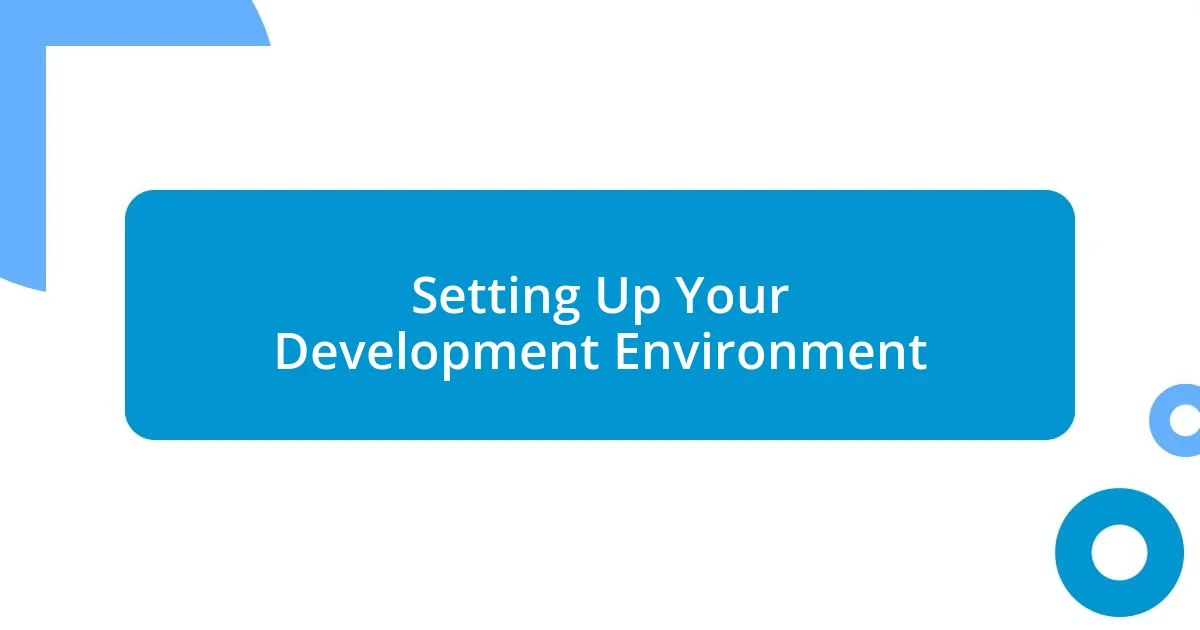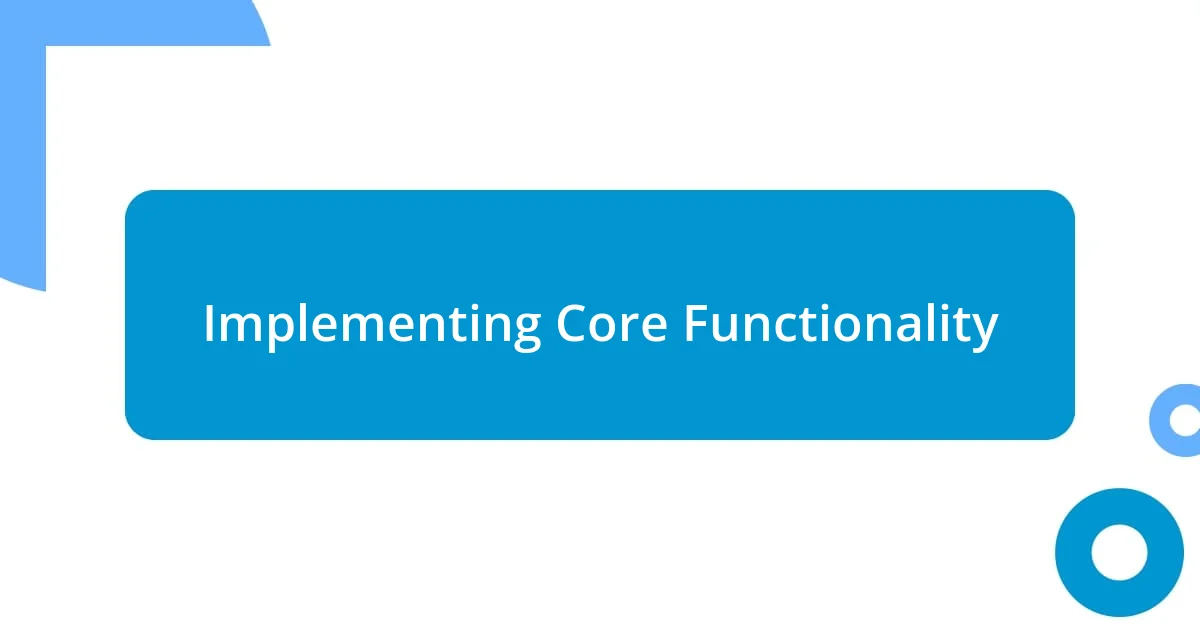Key takeaways:
- Understanding APIs allows for effective communication between software applications, enhancing development opportunities and user experiences.
- Choosing the right technology stack and setting up a structured development environment are crucial for smooth API development and future scalability.
- Testing and maintaining the API through feedback loops and updates is vital for ensuring reliability and improving user satisfaction over time.

Understanding API Basics
Understanding the basics of an API is crucial for anyone looking to venture into programming. I vividly remember the first time I encountered the term API. It felt like a secret code that promised to unlock the complexity of how different software applications communicate. This feeling of stepping into a new world was both exhilarating and a bit intimidating.
APIs, or Application Programming Interfaces, act as bridges allowing different software programs to talk to each other. It’s like having a bilingual friend who translates your thoughts to someone who speaks a different language. Do you remember the first time you found it difficult to express yourself in a new language? That’s how software interacts without APIs; they struggle to understand one another.
What fascinated me most about APIs was their flexibility and power. They enable developers to create applications that can leverage existing services easily. For instance, I’ve built functions in my projects that pull weather data from a third-party API. The thrill of watching my code interact with a vast ocean of information was like witnessing a magic trick unfold. Why do APIs feel so transformative? Because they broaden the horizon of what’s possible with technology, inviting both creativity and practicality into one package.

Choosing the Right Technology Stack
Choosing the right technology stack for your API is sometimes challenging yet incredibly exciting. I remember when I was at this crossroads, trying to decide between various frameworks and languages. It felt like choosing ingredients for a favorite recipe; each one brought something unique to the table, and I had to consider how they would blend together to create a harmonious final product.
For instance, I weighed the pros and cons of Node.js, with its event-driven nature, against Python’s simplicity and elegance. My decision shifted with every article I read and every conversation I had with fellow developers. Ultimately, I realized it was about finding a balance: the ease of use, the community support, and the specific needs of my project. Reflecting on this, I now see how vital it is to choose technologies that not only align with the current demands but also have the potential to grow with my subsequent projects.
When considering options, don’t forget the importance of scalability and performance. I’ve encountered scenarios where a chosen stack was perfect for a small project but faltered as it grew. Trust me, pondering these factors early on will save you from a lot of headaches later!
| Technology | Strengths |
|---|---|
| Node.js | High performance for real-time applications. |
| Python (Flask/Django) | Simplicity and readability, with rapid development. |
| Java (Spring) | Stability and scalability for large applications. |
| Ruby (Rails) | Convention over configuration, fast development cycle. |

Setting Up Your Development Environment
Setting up a development environment can feel like laying the foundation of a house; it might seem tedious, but it’s completely worth the effort. I vividly recall the time I was wrestling with various setups – it was frustrating at times, like trying to remember where I left my keys in a chaotic room. But when I finally got everything in order, I felt that rush of clarity and productivity wash over me, turning chaos into control.
Here’s a quick checklist to make your setup smoother:
- Choose a Text Editor or IDE: I recommend VSCode for its vast extensions and user-friendly interface.
- Install a Version Control System: Git is essential; it saved me from losing countless hours of work.
- Set Up a Local Server: I initially struggled with local server environments until I discovered tools like XAMPP.
- Add Essential Libraries: Depending on your chosen tech stack, having libraries ready can simplify your work.
- Use a Virtual Environment: For Python, I found virtualenv invaluable, ensuring project dependencies didn’t clash.
A systematic approach makes everything less daunting. When I finally understood that getting the environment right was half the battle won, I could focus on the fun parts: coding and building. Trust me, your future self will thank you for laying down this groundwork now!

Designing Your API Structure
Designing your API structure is like blueprinting a building; it’s where the actual architecture takes shape. I remember getting excited about sketching out my endpoints, envisioning how they would interact with one another. It was a bit like planning a trip—every destination (or endpoint) needed a clear path and purpose, ensuring a smooth journey for anyone using my API.
One critical aspect I learned was to keep my design intuitive. Initially, I used inconsistently named endpoints, and it led to confusion even for me later on! To avoid this pitfall, I focused on RESTful principles, opting for resource-based URLs and standard HTTP methods. Reflecting on it, I see how essential it is to make the API self-explanatory, so that developers can understand it at first glance. This consideration creates a better user experience, which I later found increases adoption rates.
Documenting your API is equally essential. I can’t stress enough how creating clear, detailed documentation saved me countless hours. I vividly remember struggling to recall the purpose of specific endpoints. After deciding to document everything, it transformed my approach—like a well-organized recipe book that lets anyone step in and whip up the dish without confusion. Have you ever faced similar challenges with forgotten details in your projects? Trust me, a well-structured design paired with detailed documentation will not only help you but will also become invaluable for future collaborators.

Implementing Core Functionality
Implementing core functionality in my API was like bringing the blueprint to life. I still recall the thrill of watching my first endpoint come together, transforming lines of code into a working feature. At times, it felt overwhelming, like juggling too many balls in the air, but each successful test made the effort worthwhile.
One important lesson I learned was the value of modular coding. By breaking down functionality into smaller, manageable functions, I found it not only simplified debugging but also allowed for easier enhancements down the line. Have you ever faced a tangled mess of code and wished you had done things differently? Reflecting on those moments, I can honestly say that organizing my functions into logical components significantly improved my workflow and made maintenance a breeze.
As I implemented various features, I discovered the importance of robust error handling. Initially, my API would crash on unexpected inputs, leaving users frustrated and me disheartened. I eventually began to implement try-catch blocks and return meaningful error messages. This experience taught me that transparency in coding can enhance user trust. Have you noticed how a little extra effort in handling errors can lead to a much smoother interaction for users? Emphasizing clear error handling has not only made my API more resilient but also enriched the overall user experience.

Testing Your API Effectively
When it came to testing my API, I quickly realized that it was much more than just running a few scripts and calling it a day. The first time I put my API through a rigorous testing process, I felt like I was trying to unlock a treasure chest—each successful test unveiled new insights while also revealing unexpected bugs. Have you ever felt that rush when everything works flawlessly? It’s addictive! I found that setting up automated tests was a game-changer, as it allowed me to consistently validate my endpoints without the manual toil that so often sucks away your time and focus.
One technique that I found particularly helpful was using Postman for testing my API. I remember the satisfaction of crafting the perfect request and watching it dance seamlessly with my endpoints. It wasn’t just about checking if things worked; it was about exploring edge cases and potential fail points. Have you taken a deep dive into testing your own APIs? Each iteration taught me something new about user behavior. I began to see testing as a crucial component of my API development cycle rather than an afterthought, making the end product more reliable.
Moreover, I discovered the value of feedback loops during testing. Anytime I encountered bugs, I made it a point to note them down, almost like keeping a diary of misadventures! This practice not only helped me to rectify mistakes but also provided a roadmap for improvement. Looking back, I realize that embracing this iterative approach transformed my testing from a chore into an enlightening journey. It pushed me to ask, “What can I learn from this?” and that mindset has been invaluable in expanding my expertise and refining my API.

Deploying and Maintaining Your API
Once I got my API up and running, deploying it felt like sending my child off to their first day of school. I opted for a cloud service, which made the process smoother. The moment I clicked “Deploy” was exhilarating—I couldn’t wait to see how users would interact with my creation. Have you experienced that mix of excitement and anxiety when launching something important? I certainly did, and it reminded me of how crucial it is to ensure everything is in place before going live. Monitoring your API after deployment is just as vital. I relied heavily on logging and analytics tools to keep an eye on traffic and error rates, which has been essential for understanding user behavior and pinpointing issues.
Maintaining my API required constant attention, much like nurturing a garden. Early on, I made the mistake of thinking that once it was out there, my work was done. How naive that was! I quickly learned that updates were inevitable. Every few weeks, I would release minor version updates, often to fix bugs or enhance security. Surprisingly, each update felt like a personal victory, knowing I was improving the experience for my users. I even embraced user feedback, which has transformed how I approach changes. Have you ever received a piece of advice that turned your project around? In my case, listening to my users was a turning point that made maintenance rewarding rather than tedious.
The real challenge came with scaling. As my API became popular, so did the requests flooding in. Initially, my server couldn’t handle the sudden surge, leading to slow response times. It was frustrating—I felt like a coach watching my team struggle on the field. To tackle this, I adopted load balancing techniques and experimented with caching strategies, which helped streamline performance. Have you faced a scaling dilemma in your projects? It’s a learning curve but also an opportunity to innovate. I now view scaling not just as a technical hurdle but as an exciting part of my growth as a developer.













